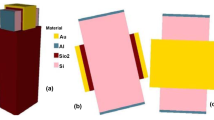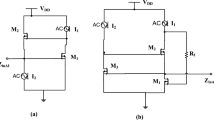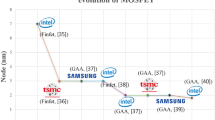Abstract
A methodology for designing ternary circuits is proposed and evaluated. The method is based on a schema that consists of voltage levels, conditional blocks and weighting elements. The main idea is selecting appropriate voltage levels in conditional blocks and weighting them to generate desired output. In fact, the diagram is a framework for designing ternary logic gates. Hence, the optimum design can be accomplished by choosing the proper strategy particularly in conditional blocks. This could lead to minimum count of elements and decrement in complexity of the circuit. To examine the efficiency of the proposed method, three designs for standard ternary inverter (STI), ternary NAND (TNAND) and ternary NOR (TNOR) gates in carbon nanotube field-effect-transistor (CNFET) technology are presented, respectively. Several simulations are done using Synopsys HSPICE tool in 32 nm CNFET technology to measure the performance parameters for proposed designs and state-of-the-art CNFET-based designs. Moreover, the robustness of STIs in different operational conditions such as variations frequency and output load, and their senility to process deviations are measured. The simulation is done for TNAND, TNOR and half adder cell as well. The results demonstrate the proper functionality of the proposed methodology. Moreover, the designed circuits benefit from the minimum count of CNFETs, least maximum equivalent input capacitor, minimum variety of CNT diameters and delay time, while its pdp is very close to best results in comparison with state-of-the-art designs.












Similar content being viewed by others
References
E. Abiri, A. Darabi, A novel design of low power and high read stability ternary SRAM (T-SRAM), memory based on the modified gate diffusion input (m-GDI) method in nanotechnology. Microelectron. J. 58, 44–59 (2016)
A. Anand, A. Islam, CNFET-based ternary inverter and its variability analysis, in Proceedings of 3rd International Conference on Reliability Infocom Technologies and Optimization (2014), pp. 1–6
S. Angizi, F. Danehdaran, S. Sarmadi, S. Sheikhfaal, An ultra-high speed and low complexity quantum-dot cellular automata full adder. J. Low Power Electron. 11(2), 173–180 (2015)
S. Bala, M. Khosla, Design and performance analysis of low-power SRAM based on electrostatically doped tunnel CNTFETs. J. Comput. Electron. 18, 856–863 (2019)
N.H. Bastani, M.H. Moaiyeri, K. Navi, Carbon nanotube field effect transistor switching logic for designing efficient ternary arithmetic circuits. J. Nanoelectron. Optoelectron. 12(2), 118–129 (2017)
G. Cho, F. Lombardi, A novel and improved design of a ternary CNTFET-based cell, in GLSVLSI’13, Proceedings of the 23rd ACM International Conference on Great Lakes Symposium on VLSI (2013), pp. 131–136
J. Deng, H.S.P. Wong, A compact SPICE model for carbon-nanotube field-effect transistors including nonidealities and its application—part I: model of the intrinsic channel region. IEEE Trans. Electron Device 54(12), 3186–3194 (2007)
J. Deng, H.S.P. Wong, A compact SPICE model for carbon-nanotube field-effect transistors including nonidealities and its application—part II: full device model and circuit performance benchmarking. IEEE Trans. Electron Device 54(12), 3195–3205 (2007)
A. Doostaregan, M.H. Moaiyeri, K. Navi, O. Hashemipour, On the design of new low-power CMOS standard ternary logic gates, in Proceedings of the 15th CSI International Symposium on Computer Architecture and Digital Systems (2010), pp. 115–120
S.A. Ebrahimi, M.R. Reshadinezhad, A. Bohlooli, M. Shahsavari, Efcient CNTFET-based design of quaternary logic gates and arithmetic circuits. Microelectron. J. 53, 156–166 (2016)
G. Hills, C. Lau, A. Wright, S. Fuller, M.D. Bishop, T. Srimani, P. Kanhaiya, R. Ho, A. Amer, Y. Stein, D. Murphy, A. Chndrakasan, M.M. Shulaker, Modern microprocessor built from complementary carbon nanotube transistors. Nature 572, 595–602 (2019)
S.L. Hurst, Multiple-valued logic-its status and its future. IEEE Trans. Comput. 33(12), 1160–1179 (1984)
S. Karmakar, A. Chandy, F.C. Jain, Design of ternary logic combinational circuits based on quantum dot gate FETs. IEEE Trans. Very Large Scale Integr. Syst. 21, 793–806 (2013)
M.R. Khezeli, A. Jalali, M.H. Moaiyeri, On the impacts of process and temperature variations on the crosstalk effects in MWCNT bundle nanointerconnects in ternary logic. IEEE Trans. Nanotechnol. 17(2), 238–249 (2018)
M.R. Khezeli, M.H. Moaiyeri, A. Jalali, Active shielding of MWCNT bundle interconnects: an efficient approach to cancellation of crosstalk-induced functional failures in ternary logic. IEEE Trans. Electromagn. Compat. 61(1), 100–110 (2019)
M.R. Khezeli, M.H. Moaiyeri, A. Jalali, Comparative analysis of simultaneous switching noise effects in MWCNT bundle and Cu power interconnects in CNTFET-based ternary circuits. IEEE Trans. Very Large Scale Integr. Syst. 27(1), 37–46 (2019)
Y. Li, M. Droste, L. Lei, Model checking of linear-time properties in multi-valued systems. Inf. Sci. 377, 51–74 (2017)
J. Liang, L. Chen, J. Han, F. Lombardi, Design and evaluation of multiple valued logic gates using pseudo N-type carbon nanotube FETs. IEEE Trans. Nanotechnol. 13(4), 695–708 (2014)
S. Lin, Y.B. Kim, F. Lombardi, CNTFET-based design of ternary logic gates and arithmetic circuits. IEEE Trans. Nanotechnol. 10(2), 217–225 (2011)
M. Maleknejad, S. Mohammadi, S.M. Mirhosseini, K. Navi, H.R. Naji, M. Hosseinzadeh, A low-power high-speed hybrid multi-threshold full adder design in CNFET technology. J. Comput. Electron. 17(3), 1257–1267 (2018)
D.M. Miller, M.A. Thornton, Multiple valued logic: concepts and representations. Synth. Lect. Digit. Circ. Syst. 2(1), 1–127 (2007)
M.H. Moaiyeri, R.F. Mirzaee, A. Doostaregan, K. Navi, O. Hashemipour, A universal method for designing low-power carbon nanotube FET-based multiple-valued logic circuits. IET Comput. Digit. Tech. 7(4), 167–181 (2013)
M.H. Moaiyeri, A. Doostaregan, K. Navi, Design of energy-efficient and robust ternary circuits for nanotechnology. IET Circuits Devices Syst. 5(4), 285–296 (2011)
S.L. Murotiya, A. Gupta, Design of high speed ternary full adder and three input XOR circuits using CNFETs, in Proceedings of the IEEE International Conference on VLSI Design (2015), pp. 292–297
K. Pilarczyk, E. Wlazlak, D. Przyczyna, A. Blachecki, A. Podborska, V. Anathasiou, Z. Konkoli, K. Szaciłowski, Molecules, semiconductors, light and information: towards future sensing and computing paradigms. Coord. Chem. Rev. 365, 23–40 (2018)
A. Raychowdhury, K. Roy, Carbon-nanotube-based voltage-mode multiple-valued logic design. IEEE Trans. Nanotechnol. 4, 168–179 (2005)
S.K. Sahoo, G. Akhilesh, R. Sahoo, M. Muglikar, High performance ternary adder using CNTFET. IEEE Trans. Nanotechnol. 16(03), 368–374 (2017)
S. Shin, E. Jang, J.W. Jeong, B.G. Park, K.R. Kim, Compact design of low power standard ternary inverter based on OFF-state current mechanism using nano-CMOS technology. IEEE Trans. Nanotechnol. 62(8), 2396–2403 (2015)
K.C. Smith, The prospects for multivalued logic: a technology and applications view. IEEE Trans. Comput. 30(9), 619–634 (1981)
N.S. Soliman, M.E. Fouda, A.G. Radwan, Memristor-CNTFET based ternary logic gates. Microelectron. J. 72, 74–85 (2018)
H.T. Tari, A.D. Zarandi, M.R. Reshadinezhad, Design of a high performance CNTFET-based full adder cell applicable in: Carry ripple, carry select and carry skip adders. Microelectron. Eng. 215, 110980 (2019)
Author information
Authors and Affiliations
Corresponding author
Additional information
Publisher's Note
Springer Nature remains neutral with regard to jurisdictional claims in published maps and institutional affiliations.
Rights and permissions
About this article
Cite this article
Doostaregan, A., Abrishamifar, A. Evaluating a Methodology for Designing CNFET-Based Ternary Circuits. Circuits Syst Signal Process 39, 5039–5058 (2020). https://doi.org/10.1007/s00034-020-01400-2
Received:
Revised:
Accepted:
Published:
Issue Date:
DOI: https://doi.org/10.1007/s00034-020-01400-2




